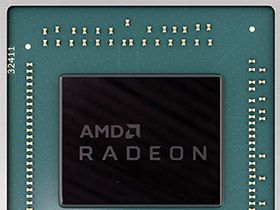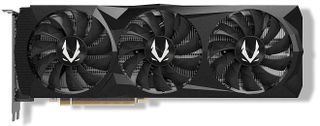Tom's Hardware Verdict
Radeon RX 5700 XT stands up better to GeForce RTX 2060 Super than we expected at the same $400 price point, simultaneously eclipsing the performance of Radeon RX Vega 64 in the process. AMD’s own Radeon VII is slightly faster, but also significantly more expensive. Although a lack of hardware for accelerating ray tracing does hurt the Radeon’s value proposition in our opinion, gamers who insist they aren’t interested in the technology have a good alternative for smooth 1440p frame rates.
Pros
- +
Almost 10% faster than GeForce RTX 2060 Super, on average, through our benchmark suite
- +
Unique card design built with high-quality materials
- +
Much better acoustics than past AMD reference cards
Cons
- -
No ray tracing acceleration
- -
Higher power consumption than GeForce RTX 2060 Super
- -
Uncomfortably hot operating temperatures (Tj > 100°C)
- -
Protection mechanisms intervene under certain synthetic workloads
Why you can trust Tom's Hardware
AMD Radeon RX 5700 XT and Radeon RX 5700 Review
11/21/2019 Update: Since the initial launch of of AMD's initial Navi cards in mid-July, we've tested some higher-clocked third-party variants, like the Sapphire Nitro+ RX 5700XT that deliver better out-of-the-box performance and colorful aesthetics.
AMD’s propensity for slowly dribbling out information about upcoming products keeps our news desk buzzing but also serves to illustrate the company’s play book months in advance. That drawn-out tease definitely worked against AMD last generation. By the time Radeon RX Vega landed in our lab, expectations had boiled over beyond what the card could deliver, particularly at its cryptocurrency-affected prices.
This time around, AMD used the Electronic Entertainment Expo in Los Angeles as the launch pad for a Navi deets, pouring out all the architectural details it was willing to divulge with less than 24 hours to write it up, then complicating matters by prohibiting audio or video recordings of the technical deep dives. But even rushing the particulars for reasons unknown couldn’t stop Nvidia from squeezing in a Turing refresh prior to Radeon RX 5700 and Radeon RX 5700 XT availability.
The two Navi-based cards originally took aim at GeForce RTX 2070 and GeForce RTX 2060. Just days before reviews were scheduled to go live, however, AMD found itself staring down the barrel of GeForce RTX 2060, 2060 Super, and 2070 Super. Its hardware was already baked, so the company turned another dial to stay competitive: it dropped the price of Radeon RX 5700 XT to $400, matching GeForce RTX 2060 Super, and lowered Radeon RX 5700 to $350, pulling up alongside GeForce RTX 2060. AMD is clearly feeling good enough about its performance story to go up against the GeForces at identical pricing. Are either of these Radeons among the best graphics cards or is AMD underestimating the appeal of real-time ray tracing support?
A Navi Recap
Check out AMD Announces Radeon RX 5700 XT and RX 5700: Navi Takes the Fight to GeForce RTX for a quick recap of Navi’s architectural basics, including its redesigned Compute Units and cache hierarchy changes.
Meet Radeon RX 5700 XT
Both AMD Radeon RX 5700-series cards are based on the same Navi GPU. Manufactured on TSMC’s 7nm FinFET process and composed of 10.3 billion transistors, these chips occupy a scant 251 mm². Vega was much larger. Manufactured on GlobalFoundries’ 14nm LPP process, it packed 12.5 billion transistors into a 495 mm² die. For some additional context, Nvidia’s competing GeForce RTX 2060-series cards employ TU106, a 10.8-billion-transistor chip measuring 445 mm² and built using TSMC’s 12nm FinFET process.
We confirmed with AMD that Radeon RX 5700 XT employs a fully-enabled version of the Navi GPU—no part of the chip is turned off to improve yields or leave room for a more resource-rich model in the future. It exposes 40 RDNA Compute Units, each with 64 Stream processors, totaling 2,560 ALUs across the processor. The CUs host four texture units, just as they did in AMD’s Graphics Core Next design, adding up to 160 in a complete Navi GPU. Four render back-ends per quadrant are capable of 16 pixels per clock cycle, yielding 64 ROPs.
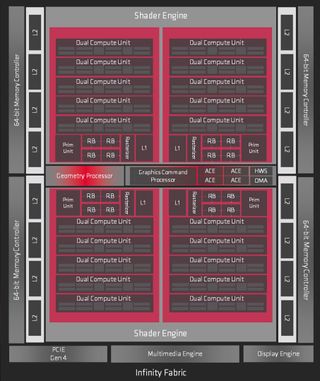
That’s clearly a more compact configuration than Radeon RX Vega 64, which featured 64 CUs with 4,096 Stream processors and 256 texture units. And yet our benchmarks will show that Radeon RX 5700 XT averages 15%-higher frame rates than Vega 64. Almost 60% of the architecture’s speed-up comes from performance per clock enhancements, according to AMD. Another 25% is attributable to gains enabled by 7nm manufacturing. The reminder falls under design frequency and power improvement, which includes more effective clock gating.
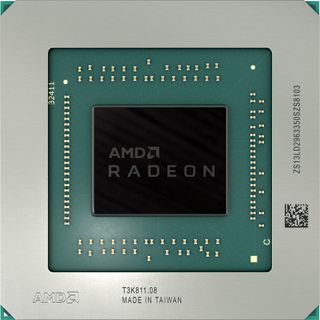
The specifications for Radeon RX 5700 XT curiously define its base clock rate as “up to 1,605 MHz.” At first, we didn’t think anything of this. After subjecting the 5700 XT to synthetic workloads like FurMark, however, and observing frequencies as low as 1,575 MHz, it appears that the base can be violated under the right (or wrong) conditions, favoring a consistent acoustic experience over strict performance boundaries. AMD also specifies a Game GPU clock of “up to 1,755 MHz” and a Boost GPU clock of “up to 1,905 MHz.” As you might guess, both ratings are subject to certain conditions. In fact, we saw Boost frequencies well above 1,905 MHz at the start of many games. As the card warms up, though, expect to see clock rates closer to the Game GPU clock.
Let’s just throw this out there: We’d prefer that AMD not create a third frequency rating. Because it is fleeting, it’s subject to abuse. In fact, AMD is already using that peak figure to calculate its 9.75 TFLOPS FP32 performance figure. The more sustainable 1,755 MHz Game GPU clock translates to 9 TFLOPS, and that just doesn’t look as thunderous next to GeForce RTX 2060 Super’s 7.2 TFLOPS, right? Navi does carry over support for rapid-packed math, so AMD cites half-precision performance of up to 19.5 TFLOPS.
An aggregate 256-bit pathway is populated by 8GB of GDDR6 operating at 14 Gb/s. This gives Radeon RX 5700 XT up to 448 GBps of memory bandwidth—slightly less than Radeon RX Vega 64’s 484 GBps but significantly more than Radeon RX 590’s 256 GBps. AMD claims other notable improvements throughout Navi’s memory hierarchy, from reduced congestion in its 4MB L2 cache to a new 128KB L1 cache per quadrant that helps reduce latency.
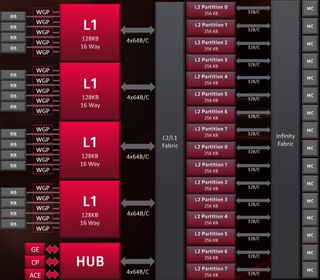
AMD considers PCIe 4.0 support one of its most noteworthy competitive advantages. The Radeon RX 5700 XT and standard 5700 both enable the latest standard’s 16 GT/s transfer rate on compatible platforms. However, we don’t have the requisite hardware to test for PCIe 4.0’s theoretical 32 GBps of throughput (two of our other labs received the X570-based setups for Ryzen testing). If AMD is going to say the time isn’t right for hardware-accelerated ray tracing, then surely the need for more bus bandwidth falls ever further down the priority list for gamers.
Although Radeon RX 5700 XT hosts a much more sophisticated GPU than Radeon RX 590 and is indeed faster than Radeon RX Vega 64, its total board power rating is 225W. That’s the same TBP as RX 590. As we’ll see in our power analysis, the 5700 XT dutifully obeys this ceiling, too.
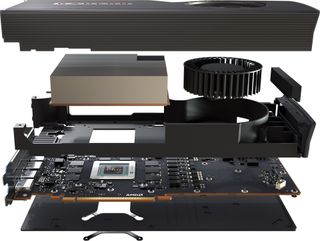
AMD covers Navi 10 with a much more artistic shroud than we’ve seen the company use previously. Representatives claim the contour design helps optimize airflow and minimize acoustic output, and we can attest that the 5700 XT is one of the quietest AMD reference cards we've tested. An aluminum alloy shell wraps around this card’s top, front, and bottom, enveloping the entire cooler. One end is open, facilitating ambient air intake, yet is still decorated with red pinstripes, Radeon branding, and black-painted aluminum fins.
The other end is loaded with slats for ventilation. Three DisplayPort 1.4 connectors and one HDMI 2.0b interface run along the PCB’s edge. It’s worth noting that Navi is AMD’s first GPU with Display Stream Compression technology, supporting 4K monitors at 144 Hz through a single cable without resorting to chroma subsampling.

Up top, eight- and six-pin auxiliary connectors feed the 5700 XT’s seven-phase power system. Another pair of pin stripes add a sporty accent, while that Radeon logo lights up red.
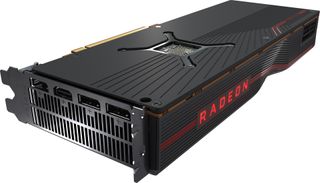
Around back, an aluminum plate covers most of the PCA, protecting it from accidental drops.
Ambient air is pulled in to the 70mm centrifugal fan and blown through an array of aluminum fins sitting on top of a vapor chamber cooler. The heated air is exhausted out the back of your chassis rather than recirculated. Of course, the downside of this design is more noise than many axial fan-based solutions and less airflow, resulting in higher GPU temperatures.
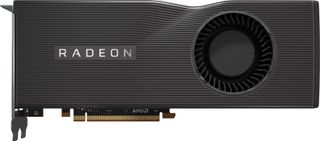
AMD’s reference 5700 XT is quite a bit longer than Nvidia’s GeForce RTX 2060 Super: it measures 10.75 inches from the expansion bracket to back edge. The Nvidia card is roughly 9 inches long in comparison. They’re close to the same height though, and the two cards similarly fit into a dual-slot form factor. It comes as no surprise that AMD’s vapor chamber adds notable heft. Whereas the reference GeForce RTX 2060 Super registers 2lb 2.2oz on our scale, Radeon RX 5700 XT weighs in at 2lb 7.2oz.
Meet Radeon RX 5700
Radeon RX 5700 is a close relative of the higher-end model. It’s based on the same graphics processor, sits on the same circuit board, and utilizes a similar thermal solution. The 5700’s appearance just isn’t as fancy. An aluminum shroud does wrap around the cooler, including its back edge. But instead of LED lighting, racing stripes, or textured ridges, it’s a plain shade of flat grey with a couple of red Radeon decals. That's fine by us; the clean colors and lines look good.
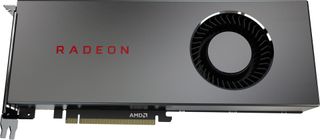
A 185W board power rating justifies eight- and six-pin auxiliary connectors up top, along with the same 70mm blower-style fan and vapor chamber cooler found on Radeon RX 5700 XT. You don’t get a backplate this time around. Nevertheless, Radeon RX 5700 still weighs more than GeForce RTX 2060 Super. At 2lb 3.2oz, it carries an extra ounce around its hips.
AMD brings similar display connectivity here, so you get three DisplayPort connectors and one HDMI port.

Under the hood, Navi is trimmed down slightly. Thirty-six of the chip’s 40 Compute Units remain active, cutting its Stream processor and texture unit count to 2,304 and 144, respectively. AMD also detunes Navi’s clock rates. The base frequency is “up to 1,465 MHz,” the Game clock is “up to 1,625 MHz,” and the so-called Boost rating is “up to 1,725 MHz.” AMD uses those figures to claim a peak FP32 rate of 7.95 TFLOPS, though a more practical specification would land between the Boost and Game frequencies based on our measurements.
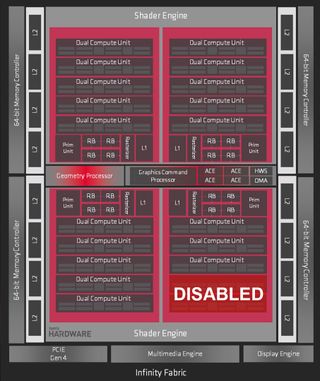
Aside from the four missing CUs, Navi remains otherwise intact for Radeon RX 5700. That means all its caches remain active, along with the 256-bit memory bus hosting 8GB of 14 Gb/s GDDR6.
Priced at $350, Radeon RX 5700 finds itself going up against GeForce RTX 2060.
| Header Cell - Column 0 | Radeon RX 5700 XT | GeForce RTX 2060 Super | Radeon RX 5700 | GeForce RTX 2060 FE |
|---|---|---|---|---|
| Architecture (GPU) | RDNA (Navi 10) | Turing (TU106) | RDNA (Navi 10) | Turing (TU106) |
| ALUs | 2560 | 2176 | 2304 | 1920 |
| Peak FP32 Compute(Based on Typical Boost) | 9 TFLOPS | 7.2 TFLOPS | 7.5 TFLOPS | 6.45 TFLOPS |
| Tensor Cores | N/A | 272 | N/A | 240 |
| RT Cores | N/A | 34 | N/A | 30 |
| Texture Units | 160 | 136 | 144 | 120 |
| Base Clock Rate | 1605 MHz | 1470 MHz | 1465 MHz | 1365 MHz |
| Nvidia Boost/AMD Game Rate | 1755 MHz | 1650 MHz | 1625 MHz | 1680 MHz |
| AMD Boost Rate | 1905 MHz | N/A | 1725 MHz | N/A |
| Memory Capacity | 8GB GDDR6 | 8GB GDDR6 | 8GB GDDR6 | 6GB GDDR6 |
| Memory Bus | 256-bit | 256-bit | 256-bit | 192-bit |
| Memory Bandwidth | 448 GB/s | 448 GB/s | 448 GB/s | 336 GB/s |
| ROPs | 64 | 64 | 64 | 48 |
| L2 Cache | 4MB | 4MB | 4MB | 3MB |
| TDP | 225W | 175W | 185W | 160W |
| Transistor Count | 10.3 billion | 10.8 billion | 10.3 billion | 10.8 billion |
| Die Size | 251 mm² | 445 mm² | 251 mm² | 445 mm² |
How We Tested Radeon RX 5700 XT and Radeon RX 5700
AMD shipped us its Radeon RX 5700 and 5700 XT cards with plenty of time to test. But Nvidia cut in with the GeForce RTX 2060 Super and 2070 Super, condensing our schedule considerably. Regardless, we still managed to test all four cards on a brand-new platform powered by Intel’s Core i7-8086K six-core CPU on a Z370 Aorus Ultra Gaming motherboard with 64GB of a Corsair CMK128GX4M8A2400OC14 kit. We’re still using a couple of 500GB Crucial MX200 SSDs for our gaming suite, along with Noctua’s NH-D15S heat sink/fan combo.


Of course, this required building a new library of data with a limited amount of time to do it. We started with a selection of cards relevant to the new GeForces, and then added AMD’s Radeon RX 5700-series boards. From Nvidia, that includes GeForce RTX 2080, GeForce RTX 2070, GeForce RTX 2060, GeForce GTX 1080 Ti, GeForce GTX 1080, GeForce GTX 1070 Ti, and GeForce GTX 1070. All of those cards are represented by Nvidia’s own Founders Edition models except for the 1070 Ti, which is an MSI GeForce GTX 1070 Ti Gaming 8G. AMD’s own Radeon VII is part of the comparison as well, along with Sapphire’s Nitro+ Radeon RX Vega 64 and Nitro+ Radeon RX Vega 56. Those partner cards ensure we don’t see the frequency/throttling issues encountered with our reference models.
Our benchmark selection includes Battlefield V, Destiny 2, Far Cry 5, Final Fantasy XV, Forza Horizon 4, Grand Theft Auto V, Metro Exodus, Shadow of the Tomb Raider, Strange Brigade, Tom Clancy’s The Division 2, Tom Clancy’s Ghost Recon Wildlands, The Witcher 3 and Wolfenstein II: The New Colossus.
The testing methodology we're using comes from PresentMon: Performance In DirectX, OpenGL, And Vulkan. In short, these games are evaluated using a combination of OCAT and our own in-house GUI for PresentMon, with logging via GPU-Z.
We’re using driver build 431.16 for Nvidia’s GeForce RTX 2060 and 2070 Super and build 430.86 for all the other Nvidia cards. On AMD’s side, we’re using Adrenalin 2019 Edition 19.6.3 for all three existing cards, plus 19.7.1 for the Radeon RX 5700-series cards.
MORE: Best Graphics Cards
MORE: GPU Benchmarks
MORE: All Graphics Content
Current page: AMD Radeon RX 5700 XT and Radeon RX 5700 Review
Next Page Performance Results: 2560 x 1440-
ICWiener Honestly I'd pay the extra just for Nvidia's decent cooler, let alone power consumption, RTX, etc. Hard pass on another blower.Reply -
justin.m.beauvais Dear AMD,Reply
Why? Wasn't your line GTX 1080 performance at RX 580 prices? points at Navi This is not that.
Regrettably yours,
Your Fans -
alextheblue Reply
I read the review, don't know what you mean by "let alone power consumption". Efficiency is virtually the same. I personally prefer blowers as long as they're not crazy loud, and the review says they're not so I'm all for it. If you DON'T like blowers, I'm sure there will be third-party coolers that improve cooling performance and acoustics further (and dump heat into the chassis like crazy).ICWiener said:Honestly I'd pay the extra just for Nvidia's decent cooler, let alone power consumption, RTX, etc. Hard pass on another blower.
Who ever promised that? They are 10-11% faster than same-priced Nvidia models. They're not going to drop 5700 $100 bucks when they're already ahead by 11%, even though I would love lower prices, there's no incentive for them to do so.justin.m.beauvais said:Dear AMD,
Why? Wasn't your line GTX 1080 performance at RX 580 prices? points at Navi This is not that.
Regrettably yours,
Your Fans -
face-plants I'm pleasantly surprised by both the performance AND the last-minute drop in price. Personally I don't like blower style cards and will be on the lookout for third-party offerings with more traditional dual fan coolers. This is totally personal preference as I tend to build in bigger cases with plenty of ventilation to deal with the extra heat. If the prices don't get too out of line from the AIBs then I'll gladly give a few of these cards a go in upcoming builds. I'm also expecting a decent improvement in thermals so hopefully these FE cards aren't exemplary of the best cooling you can get on air. The prospect of building all AMD machines in the coming months has got me totally nerding out.Reply -
kinggremlin Replyalextheblue said:I read the review, don't know what you mean by "let alone power consumption". Efficiency is virtually the same. I personally prefer blowers as long as they're not crazy loud, and the review says they're not so I'm all for it. If you DON'T like blowers, I'm sure there will be third-party coolers that improve cooling performance and acoustics further (and dump heat into the chassis like crazy).
Who ever promised that? They are 10-11% faster than same-priced Nvidia models. They're not going to drop 5700 $100 bucks when they're already ahead by 11%, even though I would love lower prices, there's no incentive for them to do so.
You didn't read the review. Ignoring the Furmark results which don't mirror any realworld scenario. The 5700xt is slower than the 2070 Super while using more power and running over 10degrees C hotter in gaming. -
alextheblue Reply
Yes, I did, stop being obstinate. Ah, I get it, you must have read "efficiency" in my post as "power consumption", or something. Why are you comparing it to the 2070 Super? The 5700 is the same price as the 2060 and 11-12% faster on average (between TH and AT), and the 5700XT is the same price as the 2060 Super and roughly 10-11% (TH-AT) faster. Yes, they use more power, but they're faster. As a result the efficiency is pretty close. It varies based on workload (game title), but I have read the reviews here and AT (so far, haven't looked at a third review yet). Here:kinggremlin said:You didn't read the review. Ignoring the Furmark results which don't mirror any realworld scenario. The 5700xt is slower than the 2070 Super while using more power and running over 10degrees C hotter in gaming.
https://www.anandtech.com/show/14618/the-amd-radeon-rx-5700-xt-rx-5700-review/15
Factor in the performance gain (in AT's suite it was 11% for the XT and 12 for vanilla 5700) and you'll see their power consumption is pretty good. Average that with TH's results in Metro: LL and the final efficiency is pretty neck and neck with their direct competitors.
I didn't say they didn't run hot. For people that don't like blowers (as I already said) there will be cooler, quieter third party options. -
digitalgriffin Replyalextheblue said:I read the review, don't know what you mean by "let alone power consumption". Efficiency is virtually the same. I personally prefer blowers as long as they're not crazy loud, and the review says they're not so I'm all for it. If you DON'T like blowers, I'm sure there will be third-party coolers that improve cooling performance and acoustics further (and dump heat into the chassis like crazy).
Who ever promised that? They are 10-11% faster than same-priced Nvidia models. They're not going to drop 5700 $100 bucks when they're already ahead by 11%, even though I would love lower prices, there's no incentive for them to do so.
In all honesty, all these cards are expensive. $350 would have been the most I wanted to pay for a 5700XT. And the card does run hot. Pascal was a small move up in prices. Turing was just insane pricing wise.
That being said I bought one today and said "F"-it. I just don't like NVIDIA's business ethics. It will get the job done for two to three years. -
randomizer How many engineers looked at those fan curves in lab testing and thought they were good?Reply
I think this release is a bit underwhelming. Local pricing here makes the RX 5700 fairly unattractive compared to a 2060, but the XT is better positioned against the 2070. Not sure it's really worthwhile upgrading a 970 though. -
daglesj So for the many of us on a RX480?...Reply
Worth it? Could someone not dig out the previous AMD midrange value demon to test against? C'mon...
